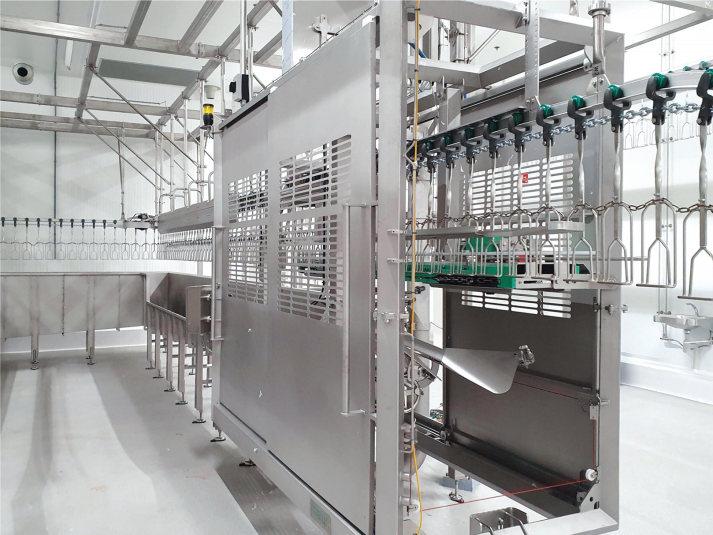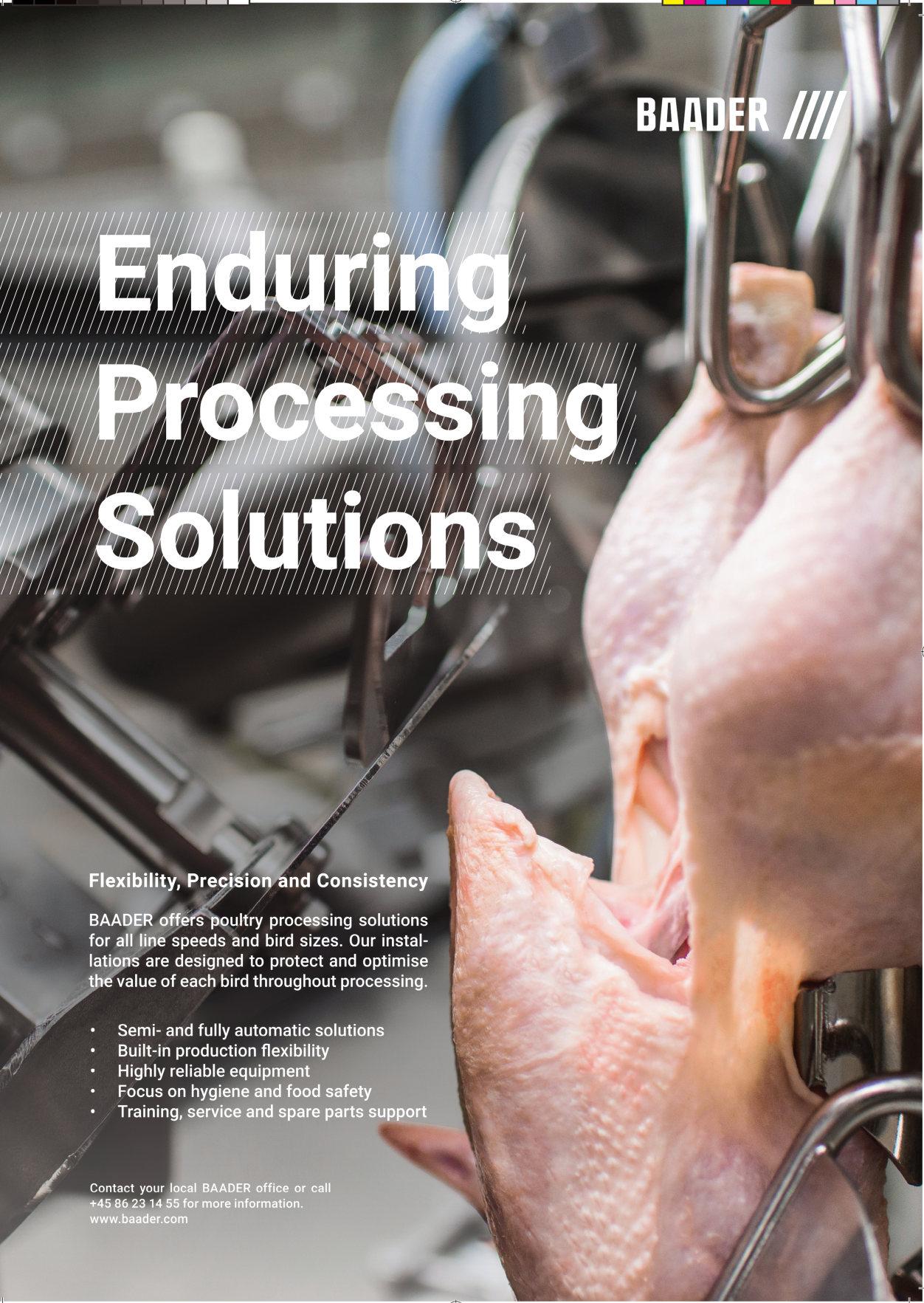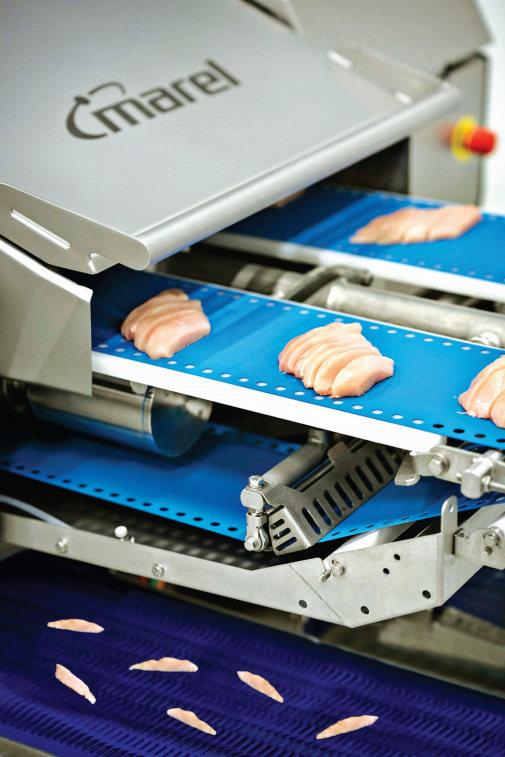
14 minute read
Poultry
The need to reduce human intervention and shortage of labour has increased the demand for automated poultry processing machines. The use of IoT and AI in the food processing industry will grow in future.
Future of poultry processing
TYSON VENTURES RECENTLY participated in a US$10mn funding which aims to bring an artificial intelligence robotics solution to the poultry processing market.
But this is not the first time, they have invested close to US$215mn in the past five years. While Soft Robotics technology was used to carry out the function of bulk picking processes in the past, the increasing shortage of labour, pre and post-pandemic has brought forth an increased need to reduce human intervention in the poultry processing industry.
At present, the increased reliance of AI and automation in the processing industry is the only way to continue business in the food industry.
In addition, the demand by quick service restaurants for high volumes of portioned products has made it mandatory to keep machines that offer quick and large amounts of sliced, deboned or cubed pieces of meat, which is in so much demand right now. The challenges for the poultry processing industry are manywhether it is food safety, cutting and deboning with maximum productivity in little time or automating the entire process, to reduce human intervention. There are various industry leaders who are constantly innovating the poultry processing industry.
Foodmate’s OPTIX Intelligent Thigh Deboner
Foodmate introduced the OPTIX – the intelligent thigh deboner, their second intelligent deboning solution with X-Ray measuring technology in 2019. Their latest launch, the Automatic Transfer Loader is an effective solution as a replacement for human labour during the pandemic. The Automatic Transfer Loader takes the product from the cut up line and places the product in the OPTIX.
PPO’s Hyperspectral Imaging Technology
P&P Optica (PPO) has started with its new project which entails the development of the company’s advanced software, and insights for the food processing industry. The new technology includes artificial intelligence (AI) tools that will enable processors to collect, view, and analyse detailed information about food composition and quality in real-time. PPO was already using the Smart Imaging System which applies hyperspectral imaging to collect comprehensive data on the product it inspects. The system then provides information on quality metrics, such as the fat/lean ratio for bacon and sausage, tenderness of steaks, and identifies muscle myopathies in chicken.
PPO’s system can identify foreign material and contaminants, such as rubber, cardboard and clear plastics, which other detection methods such as x-rays and metal detectors seem to miss.
SINTEF’s Gribbot
At least five years ago, the engineeers at SINTEF, Scandinavia’s independent research centre, developed a DENSO VS 087 robot, also called the Gribbot, to harvest chicken fillets. The Gribbot consists of a transport system, a machine vision subsystem, a robot arm and a compliant gripper. The DENSO VS 087 robot-based concept used 3D machine vision as the eye, and the DENSO robot serves as its arm, and the compliant gripper functions as the hand.
DENSO VS 087 is an IP67-rated robot, suitable for working with food raw material, and the fastest robot arm in its class. The equipment is interlaced in LabView, including the 3D machine vision and the system’s gripper is also controlled via the built-in solenoid valves in the robot arm. SINTEF used the built-in electrical wiring of the DENSO V087 to send and receive necessary signals from the gripper and connected the machine vision to the controlling computer, which could be accessed via LabView.
The Gribbot can process a chicken breast in about 2-3 seconds, which translates into one or more Gribbots doing the work of 30 operators. The innovation will result in huge savings for the industry, and save human labour from repetitive tasks.
The Gribbot seems to be a promising technology for the food industry. The potential benefits are many, such as, optimising the entire production, making the operations cost and time efficient, and an optimal utilisation of raw materials. In future, the system can be applied to other, similar tasks throughout the food processing industry.
Marel
The I-Cut 122 TrimSort can cut various highvalue boneless products, from a single stream of incoming products, distributing accurately into two streams at a high speed. The integrated TrimSort functionality and smarter software allow for the distribution of
The Killer M2.0’s offers increased speed and productivity, along with safety of the user.

different combinations of cut products to the two integrated belt pairs. This further reduces human intervention. All of this is done in one smart system with a small footprint, without the need for additional machines.
The I-Cut 122 TrimSort can portion a fillet into a smaller fillet, useful off-cuts and trim. The smaller cut fillet can be used for many supermarket and QSR products, such as fixed-weight fillet packs or whole muscle meat burgers. The cut-off medallions, strips or cubes, together with trim, are sorted on the second, lower internal conveyor belt which takes these portions to another process, so that they can be used in quick service restaurants, for whole muscle chicken wraps, chicken salads or ‘crispy tenders’.
The super-fast opening and closing belts do a reliable, meticulous sorting job, in close cooperation with the cutting knife which has an accuracy of five grams. Marel’s product specialist Morten Dalqvist says, “When a tenderloin is your input product, TrimSort can drop the tip, leave perfect cubes on the upper belt and drop the tail too. Such a job needs no operators to separate quality products from trim, making the I-Cut 122 TrimSort a labor-saving solution.”
The I-Cut 122 TrimSort is also equipped with the latest handling and communication software, which can keep the collected data connected to each product on the belt, allowing distribution to suitable destination.
Sharing product data through the process allows Marel machines to work together helping the processors to meet the requirements of retail, quick service restaurants and catering customers for high-quality portioned products in large volumes.
Meyn Food Processing Technology B.V
Meyn has been a pioneer in creating full automated smart processing systems, with product launches such as the iconic Meyn Maestro Plus which accomplishes fully automated in-line giblet harvesting, the Meyn Rapid Plus M4.2 breast deboner, and the more recent Meyn Wing cutter HY Pro, a slaughtering solution which accommodates continuous increasing line speeds, and improves food- and worker’s safety.
The Meyn Killer M2.0, the latest launch from the brand, executes a uniform and controlled cut for an optimum bleed-out. The new guide mechanisms result in limited shackle movements, reduced dragging and the fixed positioning of the head allows for a stretch and an optimal cut. It reduces time taken to slaughter flocks of different sizes, and switches between frontal cut or decapitation and changing stun methods. Processors with consistent and uniform flocks can also order the Killer M2.0 with economical, mechanical adjustments.
The smart design of the Killer M2.0’s also increases safety of the user, as the control panels and buttons for daily operations are placed away from moving parts and knives, and separated by sliding doors. The doors are fitted with grids, which offer perfect visual tracking of the process at eye level, making it easier for the operator to adjust the machine when needed.
The product zone is easily accessible for regular cleaning and inspection. The open underpart of the solution avoids pilling up

Image Credit: Marel of dirt in the machine and the designed frame eludes collected water, avoiding bacteria growth. BAADER BAADERING is a process which separates soft and solid components, and produces high quality ground meat, without bones, cartilage and sinews. BAADER’s latest machine, new BAADER 608 which supports the BAADERING process, sets new standards for food quality, value creation, process safety and userfriendliness. The interior of the machine and the control cabinet are easy to access, and the opening of the front requires no tools. The BAADER 608 has a new kind of product scraper that reduces contact between the product and the machine, ensuring that it retains its structure. The support rollers improve hygiene, whereas the pressure roller can be lowered for better handling, cleaning and adjustThe I-Cut 122 TrimSort can portion a fillet into a ment options. smaller pieces, useful off-cuts and trim. Drainage slants in the housing allow for proper water drainage, and the discharge belt allows for segregation of by-products. The provision for automatic adjustment of the squeezing belt, and the support chain tension makes the process safer. The new hydraulic perforated drum tension makes it more user-friendly. The touch display makes operating the BAADER 608 easy, as various parameters can be set for different products, and retrieved at any time. The machine also comes with an interface for further data processing.
Sustainability
If on the one hand, the poultry processing companies are investing in smarter and faster machines which work to a large extent on automation and produce quality boneless chicken meat, there are others such as Putnu Fabrika Kekava, the biggest Latvian poultry processor which plans to invest in environmentally friendly technologies and build its own solar plant to reduce The I-Cut 122 TrimSort comes carbon emissions. Putnu Fabrika Kekava’s parent company Linas Agro Group plans to equipped with the latest implement an ambitious sustainable handling and communication strategy by 2030. The company aims for efficient use of resources such as water and software, which can keep the electricity and also intends to opt for collected data connected to each product on the belt sustainable packaging, besides reducing the emission of greenhouse gases through the use of renewable energy sources. h

GI OVO launches EggsCargoSystem XL for duck and turkey eggs Poultry Africa to be held in 2022
FOLLOWING THE SUCCESS of EggsCargoSystem® for chicken eggs, GI OVO has now developed the EggsCargoSystem XL, specially designed for the transport of duck and turkey eggs.
The system consists of a tray which offers maximum comfort and protection to the eggs against breakage; along with the capacity to hold a maximum of 20 eggs at a time.
In addition, it consists of a pallet with the dimensions 120x90 cm. These pallets are exactly matched to 12 stacks of trays per row.
The system consists of a divider, which makes keeping the empty trays on top of the stacks unnecessary.
The stacks of eggs can also be slid over the divider, making the work swifter and faster. The system can be built up to five rows, containing 7,200 eggs per pallet. The entire system can also be picked up and unpacked with robots.
In the case of bad roads, the EC protector can be used, which connects the top layer of eggs with the row below, with a plastic lock, and helps prevents the top layer from jumping up when the vehicle is in motion, thereby reducing the risk of unnecessary damage to the eggs.
All parts of the EggsCargoSystem XL are made of durable plastic, with an anti-aging additive. If desired, the system can also be provided with Clean Compound, an additive which, in combination with professional cleaning of the parts, reduces the risk of contamination to a minimum. GI OVO can supply the system in almost all RAL colours and provide customer-specific instructions.

GI OVO Image Credit:
The EggsCargoSystem XL offers damage-free transport of duck and turkey eggs. www.gi-ovo.com
VNU EUROPE, THE organiser of the Poultry Africa Expo, has rescheduled the third edition of Poultry Africa (powered by VIV worldwide), which was supposed to take place in September this year. Poultry Africa will return to Kigali next year, from 5-6 October, at the Kigali Convention Centre. The decision has been taken, keeping in mind the current travelling restrictions all around the world, and the continuous uncertainties resulting from the outbreak of coronavirus.
Poultry Africa 2022 is expecting more than 2000 professional visitors at KCC, of which 40% are estimated to be international poultry professionals from East, West and North Africa.
Poultry Africa has been organising a number of engaging and interesting webinars this year to bring useful insights and global solutions concerning the African market. The first two sessions focused on animal health practices to overcome biosecurity issues in Uganda, and food security solutions related to the poultry production value chain in Nigeria, respectively.

South African poultry industry today faces a number of challenges, ranging from the quality and origins of feeds, high feed prices and the recurrence of avian influenza and disease outbreaks such as listeriosis and salmonellosis. Omniolytics has a solution.
Leveraging the power of AI, Cloud and IoT
ARECENT OUTBREAK of highly pathogenic avian influenza (HPAI) at a farm in South Africa, which led to the immediate suspension of trade in the country’s poultry products, has been seen as a serious threat to South Africa’s poultry sector.
In fact, in April 2021, South Africa’s animal health agency reported a new outbreak of HPAI to the World Organisation for Animal Health (OIE). According to the report, the presence of the HPAI virus variant was confirmed at a poultry farm after around 300 birds had died in the first week of April, leading the outbreak to be seen as a threat to South Africa’s poultry sector.
The South African poultry industry is facing a number of challenges, ranging from the quality and origins of feeds, high feed prices and the recurrence of avian influenza and disease outbreaks such as listeriosis and salmonellosis.
According to tech giant IBM, the poultry industry was valued at more than US$3.21bn in 2019, and makes up more than 16% of the total gross value of agricultural production in South Africa.
AI, Cloud and IoT
Start-up company Omniolytics, which develops smart farming solutions, is using IBM technology to address the need for commercial and emerging poultry farmers in this valuable industry to make informed, real-time decisions on potential threats and forecast dangers within the broiler house facility, and provides farmers with early warnings on potential issues – making their processes more efficient and improving production standards.
Working with IBM, Omniolytics has developed an approach that uses Internet of Things (IoT) technologies to collect data on the environmental conditions of production facilities and day-to-day management activities and processes of poultry to improve animal health, mitigate losses and assist producers in improving production efficiency, helping address food security concerns.
The suite of solutions uses IBM Watson and machine learning capabilities to identify and learn the typical behaviour of birds resulting in improved management practices. Farmers are then able to receive a more complete picture of the wellbeing of their flocks, delivered on IBM Cloud, identifying processes and environmental deviations which could point to a potential problem.
Speaking about this, Omniolytics founder Michael Samson said, “We’re introducing solutions to the market which help improve feed conversion ratios, mortality and growth rates and benchmarking practices across their production facilities. This will ensure accurate future predictions across the value chain and make poultry farming more sustainable.”
“Agriculture plays a crucial role in the success of our local economy, and through the EEIP programme we’ve been able to support Omniolytics at a critical stage of their business growth. By improving access to IBM’s Cloud and AI technologies and increasing the adoption of a range of digital solutions as we incubate and support start-ups – we’ve set out to not only support local demand, but also ensure our entrepreneurs become globally competitive. This is crucial in a post-Covid world and we’ll continue to provide innovative technology startups with advice, support and the best technologies available in the market,” commented Craig Holmes, technology leader, IBM Southern Africa.

North Africa
The Food and Agriculture Organisation of the United Nations (FAO), and the Egyptian Poultry Association (EPA), have signed a memorandum of understanding (MOU) to further their partnership to improve the performance of the poultry industry. The MOU aims to achieve the common goals of the two parties in the field, through providing advanced and innovative technological services to various production systems of the poultry industry. FAO and EPA also intend to promote integrated approaches for sustainability.
HE Al-Sayed Al-Qusayr, minister of Agriculture and Land Reclamation, said, “The MOU comes as a new and important step towards achieving the goals of promoting the poultry industry in Egypt, and preserving this national industry by achieving advanced standards of biosecurity and combating animal diseases that affect poultry and can be transmitted to humans, such as Avian Flu.” h
OmnioFarm is built on IBM Cloud and collects, processes, analyses and visualises comprehensive insights collected from integrated wireless sensors, coupled with production records and activities across the production cycle.
The poultry sector plays a key role in South Africa's economy.


